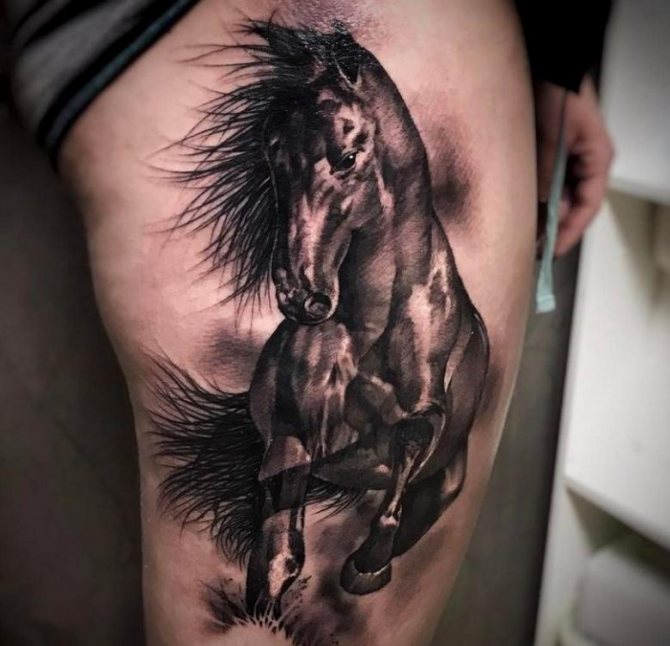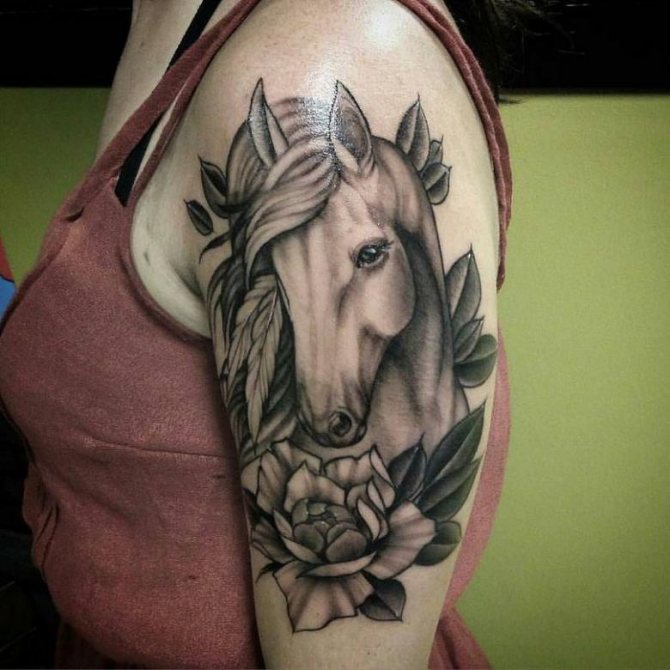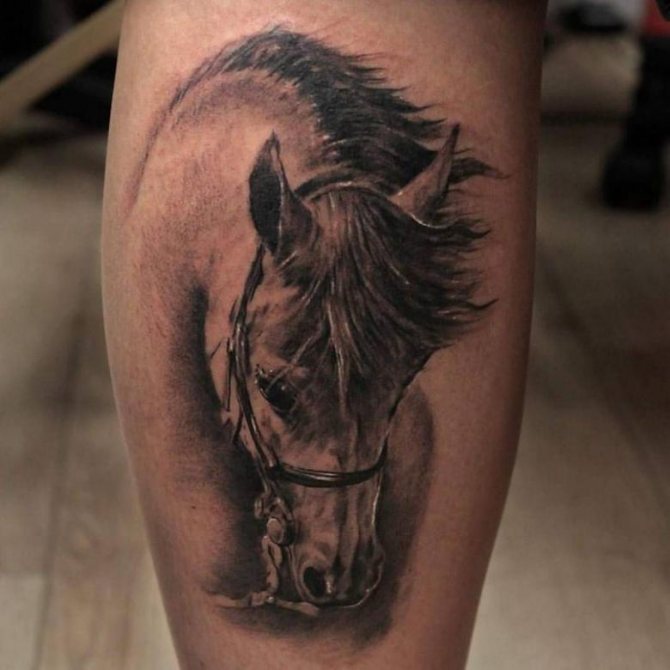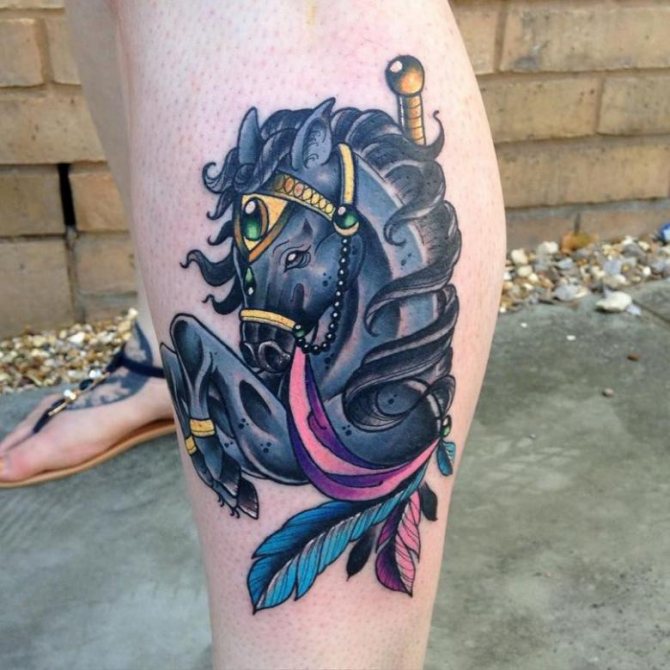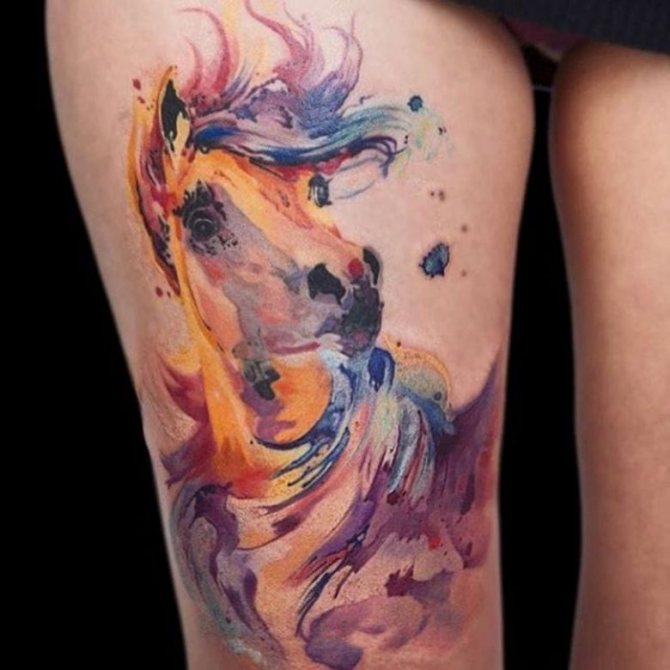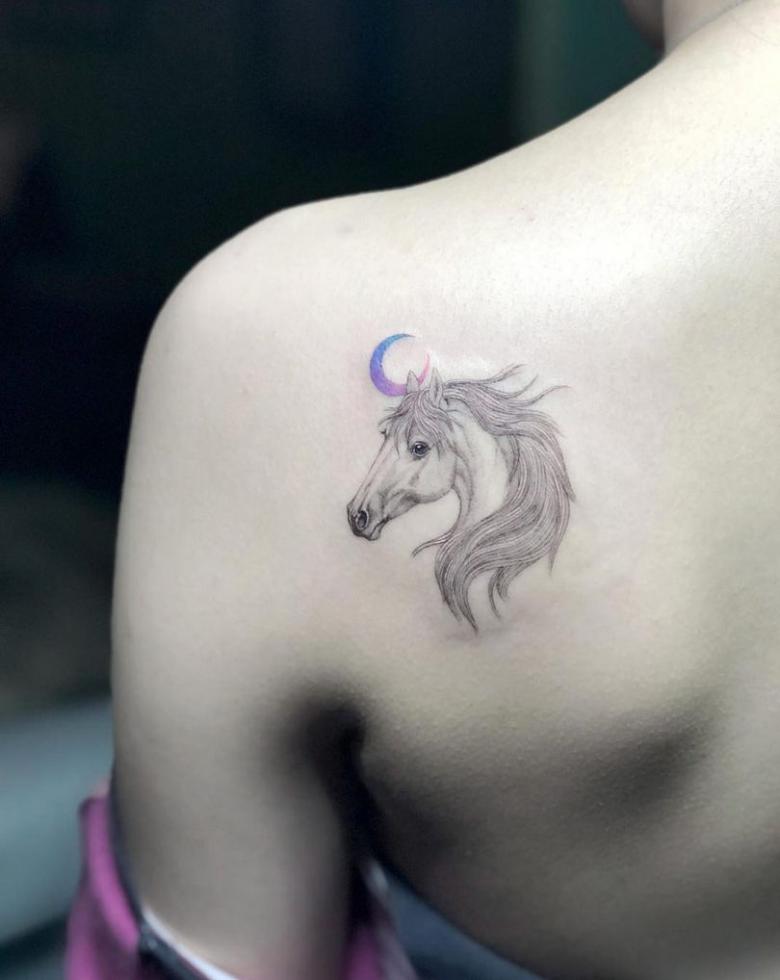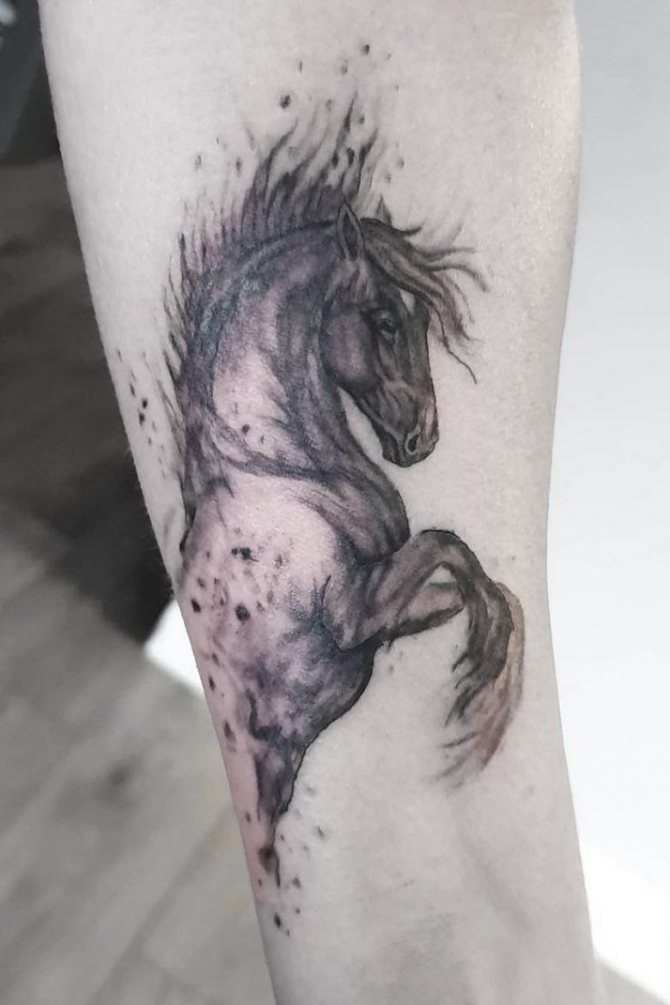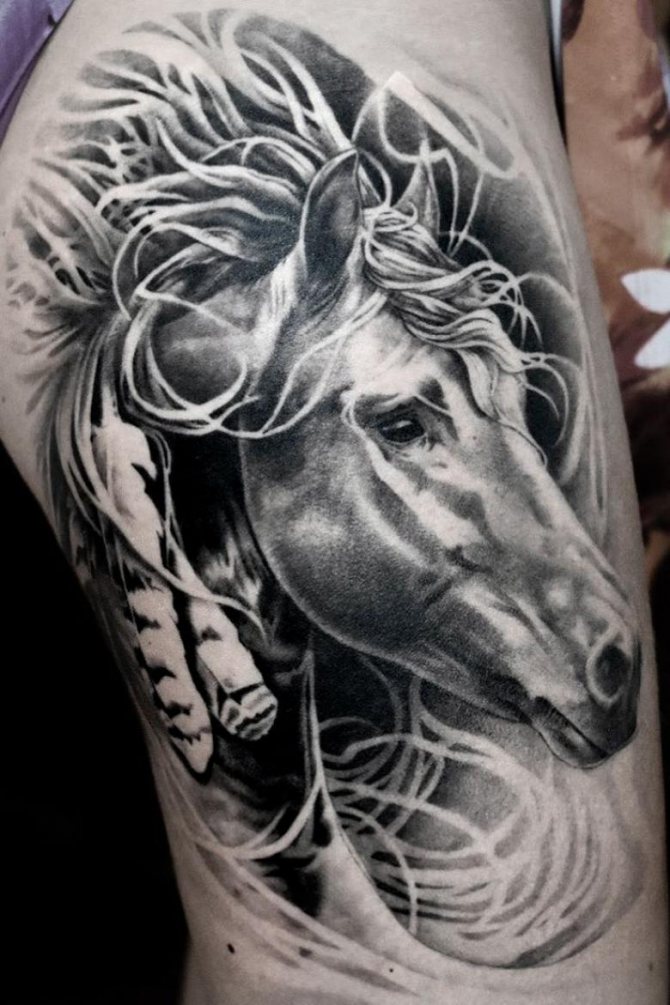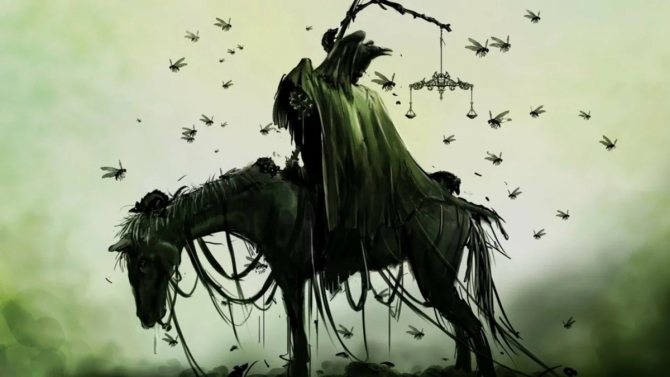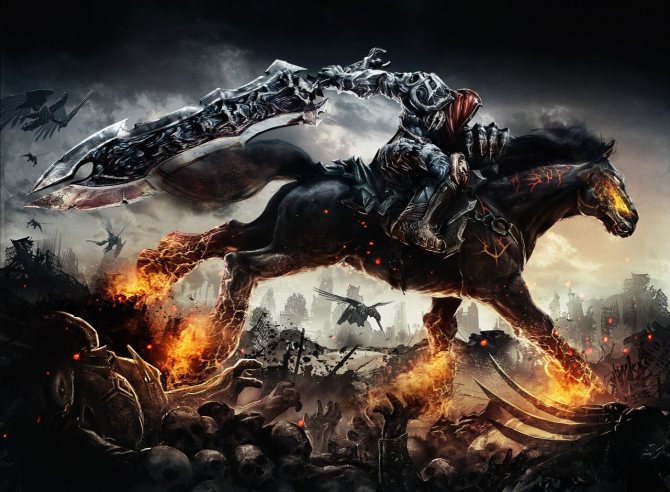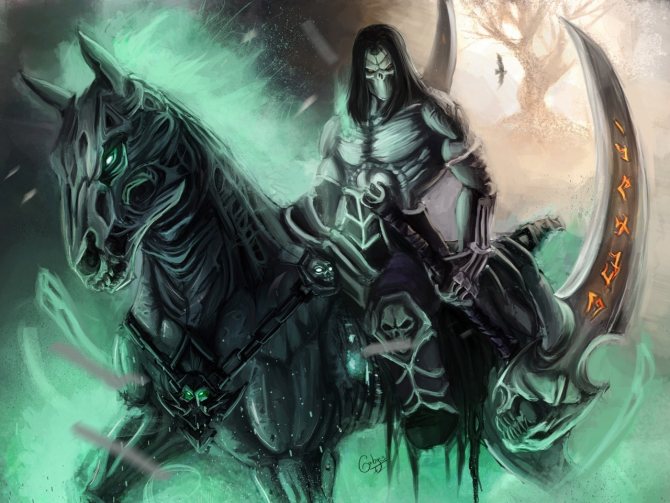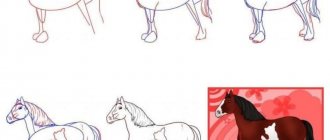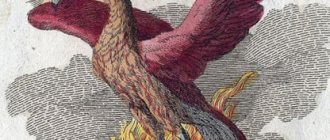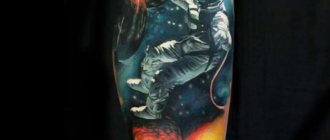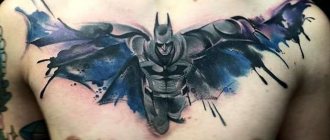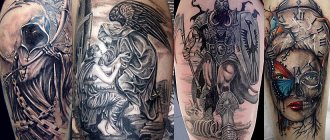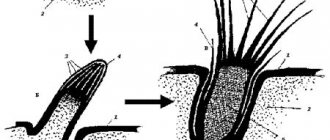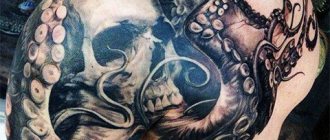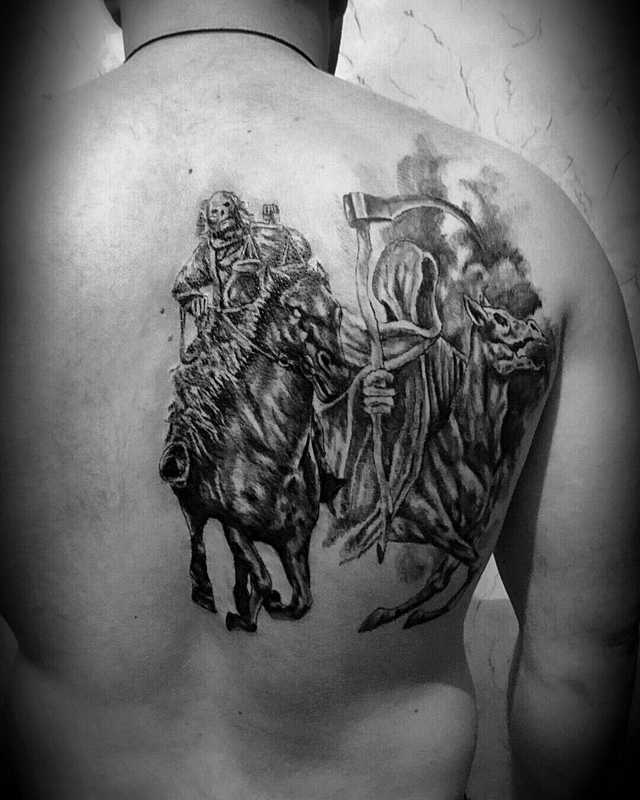
Tattoo of the Horsemen of the Apocalypse
Mythical and biblical characters and their images are endowed with deep meaning, such as the 4 Horsemen of the Apocalypse tattoo. Despite the threatening name, the picture is more majestic in nature, and speaks of the love of the owner, primarily to themselves.
Tattoo Horseman: meaning, photo tattoos, sketches
Horseman tattoo means freedom-loving, solitude, introversion, mysticism, determination, will, loyalty, devotion, travel, wandering, strength of mind, creativity, originality, uncommonness, romanticism, infantilism, cunning, unpredictability, dreaminess, detachment from the world, imagination, fantasy, courage, rebellion, bravery, courage, fortitude, power, determination, self-assurance.
Meaning of the horseman tattoo
Tattoo depicting a rider, most often choose people who are ready to go on exploits, who love adventure and travel. They can break away from their seats and already in an hour sit behind the wheel of a car, heading to the appointed place by themselves.
In most cases, these people are used to indulge their desires, not caring about their consequences. There are a large number of tattoos with a drawing of a rider, but we will consider the most popular of them.
Often Alonso Quijano is chosen as the character for the rider tattoo, which most people know as Don Quixote. As the character of this novel is an extraordinary personality, and the person who decided to leave the image of Don Quixote on his body emphasizes his detachment from the outside world and disagreement with its rules.
Like the hero of the novel this person sees the world from his angle and no external factors can convince him that his choice may be wrong.
People with such a tattoo are prone to spontaneity, confusion of the mind and always "on their own mind", it is interesting to spend time with them, but also in solitude they know what to occupy themselves with. For such people the world always remains unexplored and open.
Sometimes the image of a headless horseman is used for a tattoo. In this case, it speaks of the irascibility, aggressiveness and cunning of its bearer.
A person with a headless horseman tattoo correlates himself with the hero of the work, who even after death managed to outwit his opponent, so another of the qualities of a person with such a tattoo can be excitement and lack of fear of death.
Such a tattoo is depicted in rather gloomy colors and at first glance carries a negative message, as dark colors, severed heads and aggressive gestures of the character are used in depicting the headless horseman.
A more popular version of the horseman tattoo is the image of a wanderer on his horse. Most often it is a tired traveler who has stopped for a rest, but intends to continue on his way.
People with such a horseman tattoo often have a phlegmatic character, like to dream and make global plans for the future. They know how to calculate their strength, but on the way to the goal they meet many obstacles, to overcome which they need at least some rest.
Also, some people get a tattoo with the image of a horseman, without putting any special meaning, this image becomes a means of expressing their individuality.
Did you like the article? Tell your friends: Rate the article, it is very important to us:
Voted by: 4 people.Average rating: 5 out of 5.
History of the relationship between man and horse
Since ancient times, horses have been a friend of humans - they were the first land transport, a fighting friend and a companion for farm work. Riding over long distances was impossible without riding animals and draught devices. That is why horses always evoke positive emotions. The only harm from them is the risk of being kicked by a frightened animal. But it will not happen without reason, it is a peaceful type of creature.
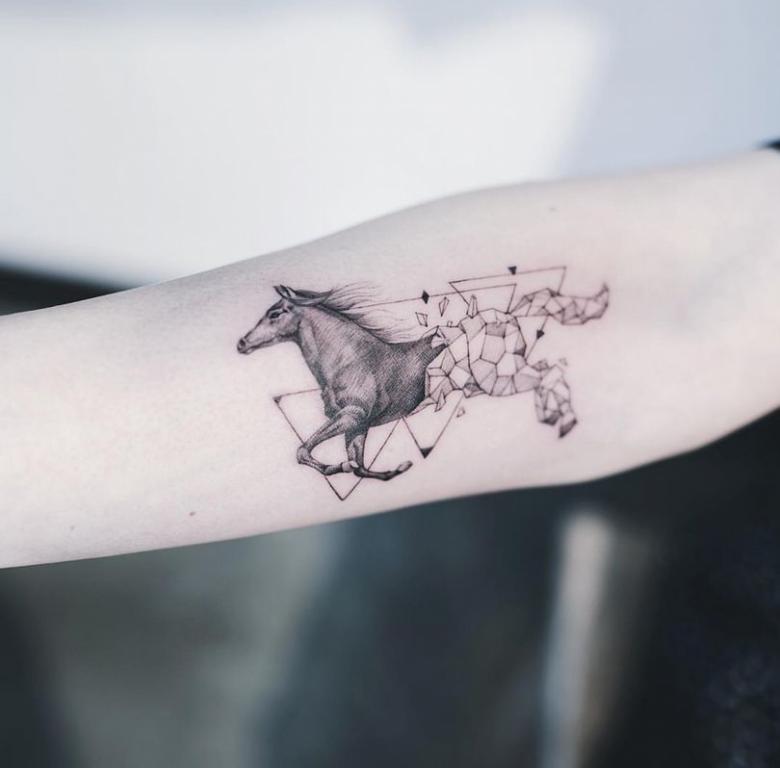

For the Slavs, the horse meant a connection with the beyond. "The pale horse" was the herald of death, and also war horses were buried with leaders and warriors. They were supposed to escort their master to the gods, to go with him to a new life. These rituals were also very popular with the Germans and Scandinavians.
The horse is the fastest animal of herbivores, against the background of predators it is a peaceful exception. In Greek culture it was a symbol of victory in war, because chariots and cavalry depended on the outcome of the battle and the advantage in battle. Horses were also sacrificed to the gods of war for future victory.
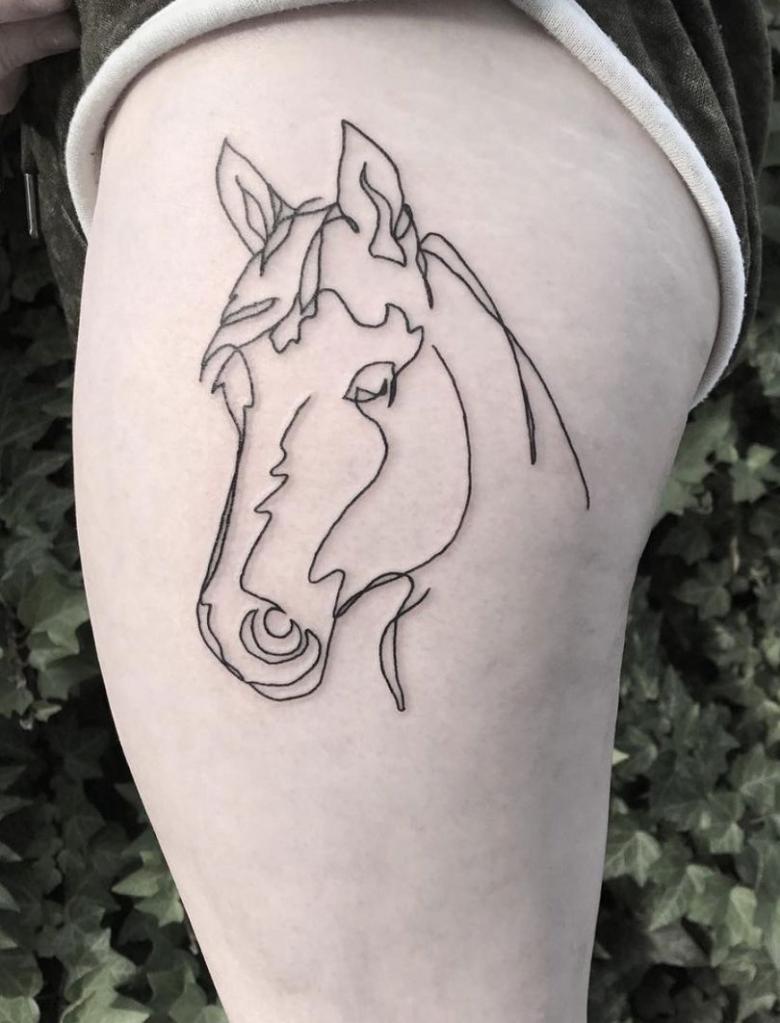

For China, it is a symbol of good news. Bearing horses were the talisman of the house and family, attracted good luck, because with them you can quickly achieve their goals. For the Japanese, it was a symbol of mercy.
What the Four Horsemen of the Apocalypse Mean
The Four Horsemen of the Apocalypse became known to the world through Revelation, which is attributed to John the Theologian, one of the 12 holy apostles. This book is the concluding part of the New Testament. It describes pictures of the last day during which God will reveal his wrath and both kings and servants will fall before him (Revelation 6:16-17).
The Apocalypse is portrayed as a monstrous global catastrophe preceding the Second Coming of God's Son. One of the most frightening and deeply symbolic scenes is the appearance of certain Four Horsemen. Theologians and scholars are still arguing what exactly the author of Revelation depicted with these images.
The White Rider
The first one to appear, after the Lamb had broken one of the seven seals, is the rider on the white horse (Revelation 6:2). The information on this character is rather scanty. John points out only that he had a crown on his head and a bow in his hand. The "white" rider is described as "victorious," i.e. who appeared to win the victory for sure.
Because of the scarcity of information about this hero, his significance and role in the Apocalyptic events are very controversially interpreted. The Roman theologian, bishop of Lyon and church father Irenaeus of Lyon (≈130-202 A.D.) believed that this mythical character symbolized Jesus Christ himself. For this reason he appears in a crown and is called the victor. The white color of the horse is a sign of righteousness and purity.
Irenaeus interpreted the appearance of Jesus at the head of the "procession" as a sign of the victory of Christianity. More common is the view of his opponents, many of whom insist that all the horsemen of the Apocalypse represent evil and have nothing to do with Jesus.
The well-known leader of the Baptist Church, Pastor William Graham calls the first horseman the Antichrist, the king of lies and strife. That is why there is a white stallion underneath him. It is a symbol of deception and false righteousness. John may have portrayed the Antichrist with a bow in his hands because of the realities of the time in which he himself lived. At the beginning of the first millennium the Roman Empire was often attacked by Parthian armies. In their vanguard were always exceptionally skilled mounted archers. They carried with them discord and death.
The Red Rider
Second in line in Revelation is the rider with the huge sword, galloping on the red horse. John describes him more concretely. The second horseman is called to destroy the world on earth (Rev. 6:4). Obviously, this character symbolizes War.
The Archbishop of Caesarea, Saint Andrew (VI-VII) believed that this rider also symbolizes the sacrifices of Christian martyrs who laid down their heads for the faith. The name of the red colored horse in some translations of the Gospel sounds like "red" or "fiery". It refers to the blood shed by the first Christians. This color is also associated with the scarlet robes of Roman emperors, the bloody tyrants of the "lecherous Roman harlot.
The Black Rider
John says of the third horseman that he holds a "measure" in his hand and sits on a raven horse (Rev. 6:5). Then a certain voice is heard, fixing a price for wheat and barley, but not allowing wine and oil to be touched (Rev. 6:6). In John's day this "measure" was used to weigh loose goods. It was used by merchants.
That the third rider holds such a measure is a symbol of hunger, both literally and figuratively. Simple food - wheat, barley - in the last days on earth will become very expensive or in short supply because of droughts. Wine and fir, on the other hand, which are used in Christian worship, will remain intact. This is an allusion to the salvation of men who live by spiritual food.
The raven colored horse is easily explained in terms of historical context. It symbolizes the color of the grapes, which were actively cultivated during the reign of Domitian (81-96). The Romans made a lot of wine from it, indulging the drunkenness of the ruling class. At the same time, the land where crops were cultivated became increasingly scarce, threatening the population with starvation.
The Pale Rider.
The author of Revelation already calls the last rider on the pale horse by name. It is Death herself. It destroys people in every way possible. Hell follows this character. Interestingly, the "pale" color of the horse in some translations from the ancient Greek sounds like a pale green, reminiscent of the color of the rotting skin of a corpse.
Modern pastors of various churches interpret the pictures depicted in Revelation with adjustments for the events of the present day. According to them the pale green horse symbolizes Islam, the red horse symbolizes communism, and the raven horse symbolizes capitalism. The crowned rider on the white stallion represents the Christian faith, which should win out in the end. This view is held, for example, by Irvin Baxter, pastor of the Church of the End Times.
Mormons interpret the alternating appearances of the horsemen of the Apocalypse as four consecutive periods. The white horse symbolizes an era of goodness and righteousness (4th-3rd millennium B.C.). The red one is a time of sin, wars, and the wrath of God who appeared on earth in the form of the Flood (3-2 millennia B.C.).
Raven - the era of Abraham, as well as the persecution, famine and wanderings of the Jewish people (2-1 millennium BC). The pale horse symbolizes the last era, which lasts until now and will end with the end of the world ("hell" for all who are lost).
Back Talk: Owners of "battered" backs talk about the subjects of their tattoos
The back is definitely a chic place for a tattoo: it's where you can capture a large drawing, a real story. Ironically, the wearer himself will only be able to see his tattoo with the help of two mirrors or a photograph. Having once made the largest drawing on the body, over time you can even forget about how it looks like.
The back gives the tattooist the opportunity to "run wild", so as drawings for this place they often choose complex large subjects and paintings with a lot of small details. We decided to find out from the owners of such tattoos, what is depicted on their backs and how they chose these subjects, and to find them, FURFUR went to the weekend "Tattoo-Convention".
PAVEL "ANGEL", 40 YEARS OLD. TATU MASTER
My back depicts one of the well-known paintings of Giger, familiar to all for the development of the appearance of "Alien", as well as for the development of a style of biomechanics. Specifically on my back is a picture of Lilith, which is a kind of female demon. According to tradition, Lilith was Adam's first woman, and she did not accept Adam, which she reported to God's lambs. But God commanded her to be with him anyway, to which she told him she would rather go to the dark side than stay with this man. So she fled, but God's servants caught up with her near the Red Sea. Then she threw herself into the Red Sea and became Lucifer's concubine.
KONSTANTIN, 28 YEARS OLD. SYSTEM ADMINISTRATOR
There's a picture of the angel of death on my back - he's just standing there, he's not doing anything special. No, well, of course he brings death and destruction, that's how it's supposed to be. On the back it's not fire, it's clouds. The tattoo isn't really done yet - I'll be getting it corrected in the near future. Also many people compare my drawing to the image of one of the characters from the game Warcraft, but in fact this angel has nothing to do with it.
ANDREY, 37 YEARS OLD. "A VAGABOND IN LIFE."
Many people say that tattoos should have a special sacred and hidden meaning, like high art, but it's all complete nonsense. My tattoo means to me a simple thought - "I'm flying where there's freedom" - I'm a vagabond, after all.
ALEXEY, 36 YEARS OLD. SPACECRAFT ENGINEER
This is as technogenic a tattoo as possible. In addition to being a construction engineer, I'm also a horoscope Scorpio. Therefore, my back depicts a biomechanical robotic scorpion, which forcibly tattoos all of its victims - instead of the usual sting, it has a giant tattoo machine.
ALEXEI, 24 YEARS OLD. COAL COMPANY WORKER
I have a picture of a fire-breathing dragon with flowers on my back - they mean prosperity, and the dragon kind of brings it. So this tattoo kind of brings me prosperity.
IVAN, AGE 23. STUDENT
I have a huge poster from the game Gears of War on my back - there's some guy with a chainsaw in the foreground and two more like that behind me. As it should be, the hero saves all the people and takes out the bad guys. But I just liked the picture, so I decided to capture it on my back.
IVAN, 22 YEARS OLD. STUDENT AT THE TATTOO STUDIO
All my tattoo - from the wrist to the back - the memory of my best friend, who, unfortunately, has already left us. He is one of the carriers of this rare style of tattooing in Saratov. Mine and his tattoos were very intertwined in terms of elements, we did them in parallel: we were very close with my buddy.
YELISEY, 24 YEARS OLD. 1C OPERATOR
I have a picture of a dragon on my back. It's just some Chinese dragon, it doesn't mean anything special. At least not to me, I just like the way it looks. And in fact, I came up with the picture myself.
ALEXANDER, 27. CEO
I have a picture on my back of Leonardo da Vinci's "The Proportions of an Ideal Man," otherwise known as "Victorian Man" (Alexander is obviously referring to the "Vitruvian Man" - Editor's note). I just finished getting this tattoo a few minutes ago. In fact, I was not guided by any philosophical sense of this work - I just liked the image.
BORIS, 33 YEARS OLD. TATTOO SHOP ADMINISTRATOR
I have four horsemen of the apocalypse drawn on my back. These four guys foreshadow the end of the world. The phrase on this tattoo, translated from Latin, reads, "Death cannot be avoided" - perfect, in my opinion, for a full-back tattoo.
Photo by: Valery Belobeev
Places of application
Tattoo horsemen of the apocalypse will take up quite a lot of space on the body, so on the wrists, ankles, calves, even with a smaller picture, will look out of place. For large tattoos for men will do the back, chest, shoulder. Girls can pay attention to the thighs, shoulders, shoulder blades.
Before applying the tattoo, you need to decide whether you want it to be seen by all, or only a narrow circle of people close to you. Open drawings on the body initially carry a protest, which corresponds to the theme of the riders. Hidden ones indicate a relationship with loved ones, and the meaning of the tattoo is done for them.
Recommended reading: Horse tattoo
The four horsemen of the Apocalypse: what they symbolize
The four horsemen of the Apocalypse became known to the world thanks to Revelation, the authorship of which is attributed to John the Theologian, one of the 12 holy apostles. This book became the final part of the New Testament. It describes pictures of the last day during which God will reveal his wrath and both kings and servants will fall before him (Revelation 6:16-17).
The Apocalypse is portrayed as a monstrous global catastrophe preceding the Second Coming of God's Son. One of the most frightening and deeply symbolic scenes is the appearance of certain Four Horsemen. Theologians and scholars are still arguing what exactly the author of Revelation depicted with these images.
The White Rider
The first to appear after the Lamb breaks one of the seven seals is the rider on the white horse (Rev. 6:2). There is scant information about this character. John points out only that he had a crown on his head and a bow in his hand. The "white" horseman is described as "victorious," that is, he appeared to be sure of victory.
Because of the scarcity of information about this hero, his significance and role in the Apocalyptic events have been very controversially interpreted. The Roman theologian, bishop of Lyon and church father Irenaeus of Lyon (≈130-202 A.D.) believed that this mythical character symbolized Jesus Christ himself. For this reason he appears in a crown and is called the victor. The white color of the horse is a sign of righteousness and purity.
Irenaeus interpreted the appearance of Jesus at the head of the "procession" as a sign of the victory of Christianity. A more common view is that of its opponents, many of whom insist that all the horsemen of the Apocalypse represent evil and have nothing to do with Jesus.
The well-known leader of the Baptist Church, Pastor William Graham, calls the first horseman the Antichrist, the king of lies and strife. That is why there is a white stallion underneath him. It is a symbol of deception and false righteousness. John may have depicted the Antichrist with a bow in his hands because of the realities of the time in which he himself lived. In the early first millennium the Roman Empire was frequently attacked by Parthian armies. In their vanguard were always exceptionally skilled mounted archers. They carried with them discord and death.
The Red Rider
Second in line in Revelation is the rider with the huge sword, galloping on the red horse. John describes him more concretely. The second horseman is called to destroy the world on earth (Rev. 6:4). Obviously, this character symbolizes War.
The Archbishop of Caesarea, St. Andrew (VI-VII) believed that this rider also symbolized the sacrifices of Christian martyrs who laid down their heads for the faith. The name of the red colored horse in some translations of the Gospel sounds like "red" or "fiery". It refers to the blood shed by the first Christians. It is also a color associated with the scarlet vestments of Roman emperors, the bloody tyrants of the "lecherous Roman harlot."
Black Rider.
John says of the third horseman that he holds a "measure" in his hand and sits on a raven horse (Rev. 6:5). Then there is a certain voice setting a price for wheat and barley, but not permitting wine and oil to be touched (Rev. 6:6). In John's day this "measure" was used to weigh loose goods. It was used by merchants.
The fact that such a measure is held by the third rider is a symbol of Hunger, both literally and figuratively. Simple food - wheat, barley - in the last days on earth will become very expensive or in short supply because of droughts. Wine and fir, on the other hand, which are used in Christian worship, will remain intact. This is an allusion to the salvation of men who live by spiritual food.
The raven color of the horse is easily explained in terms of historical context. It symbolizes the color of grapes, which were actively cultivated during the reign of Domitian (81-96). The Romans made much wine from it, indulging the drunkenness of the ruling class. At the same time, the land where crops were cultivated became increasingly scarce, and this threatened the population with starvation.
The Pale Rider.
The author of Revelation already calls the last rider on the pale horse by name. It is Death herself. It destroys people in every way possible. Hell follows this character. Interestingly, the "pale" color of the horse in some translations from the ancient Greek sounds like a pale green, reminiscent of the color of the rotting skin of a corpse.
Modern pastors of various churches interpret the pictures depicted in Revelation with adjustments for the events of the present day. According to them the pale green horse symbolizes Islam, the red horse symbolizes communism, and the raven horse symbolizes capitalism. The crowned rider on the white stallion represents the Christian faith, which should win out in the end. This view is held, for example, by Irwin Baxter, pastor of the Church of the End Times.
Mormons interpret the alternating appearances of the horsemen of the Apocalypse as 4 successive periods. The white horse is a symbol of an era of goodness and righteousness (4th-3rd millennium B.C.). The red horse is the time of sin, wars, and the wrath of God who came to earth in the form of the Flood (3-2 millennia B.C.).
The raven is the era of Abraham and the persecution, famine, and wanderings of the Jewish people (2nd-1st millennium B.C.). The pale horse symbolizes the last era, which lasts until now and will end with the end of the world ("hell" for all who are lost).

